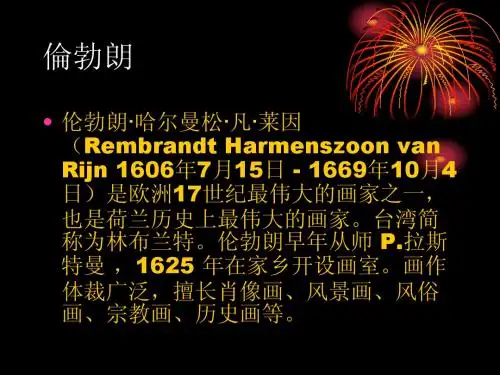Rembrandt伦勃朗英文PPT简介
- 格式:ppt
- 大小:1.77 MB
- 文档页数:5

伦勃朗ppt讲稿:主要参考《弗莱艺术批评文选》19世纪后期的荷兰绘画大师梵高面对伦勃朗的画深情的说:“你知道吗?我只要啃着硬面包在这幅画的前面坐上两个星期,那么即使少活十年也甘心。
”伦勃朗·哈尔曼松·凡·莱因(Rembrandt Harmenszoon van Rijn 1606年7月15日 - 1669年10月4日)是欧洲17世纪最伟大的画家之一,也是荷兰历史上最伟大的画家。
伦勃朗早年从师 P.拉斯特曼,1625 年在家乡开设画室。
画作体裁广泛,擅长肖像画、风景画、风俗画、宗教画、历史画等。
不过,由于古典主义是那时的时尚,伦勃朗是如此屈从于它,以至于画了几张神话作品,对文艺复兴艺术的形式也不比对其题材更感兴趣。
他看过意大利绘画和素描作品,有时候也会在自己的构图中利用它们,这也是事实。
意大利艺术只是其中之一,他从头开始,直接从生活开始。
他正是从描绘他感受到的生活开始的。
伦勃朗光线是一种普遍而善用的光线,用精确的三角立体光,勾勒出人物的轮廓线,让其余部分隐藏于光暗之中,用光线强化画中的主要部分,也让暗部去弱化和消融次要因素。
给人以稳定庄重的感觉。
伦勃朗的油画一贯采用“光暗”处理手法,即采用黑褐色或浅橄榄棕色为背景,将光线概括为一束束电筒光似的集中线,着重在画的主要部分。
这种视觉效果,就好像画中人物是站在黑色舞台上,一束强光打在他的脸上。
伦勃朗却以另一种方式成为伟大的插图画家。
作为一个插图画家,伦勃朗显示了那样一种高度的想象力,以至于能立刻以直接而又简洁的方式抓住本质,揭示它们,而无需任何附加或装饰。
这一点总是在瞬间就对我们产生愉快的惊奇感,赋予我们一种被揭示事物既自然又必然的感觉。
伦勃朗与莎士比亚及其他极罕见人物身上共同拥有的,就是这种品质。
伦勃朗与莎士比亚都拥有这样一种彻底而又坚定地创造可信生命,莎士比亚三言两语就可以为我们刻画一个栩栩如生的人物形象,伦勃朗呢,他三笔两笔就能暗示脑袋的转向或是手臂的伸张。


明暗光影艺术——浅析伦勃朗绘画作品的艺术特色伦勃朗(Rembrandt Harmenszoon van Rijn)是荷兰17世纪最具代表性的画家之一,作品以明暗光影的运用为主要特征,被称为明暗光影艺术的代表人物之一。
本文将从明暗光影的运用和对人物形象的描绘等方面,浅析伦勃朗绘画作品的艺术特色。
伦勃朗的明暗光影艺术被誉为“伦勃朗光影”,其创造出的深入空间的氛围和具有戏剧性的效果,给人留下了深刻的印象。
荷兰独特的社会背景和艺术传统的影响,使得伦勃朗画风独具一格。
他经常运用巨大的对比,在同一画面上呈现出极度明暗的效果,也常常运用光线把焦点放在人物的某个部分,强化主题的表达。
伦勃朗的明暗光影艺术还体现在他对颜色的运用上。
他并不追求艳丽的色彩,而是注重光和影的变化,通过对明暗的处理来表现色彩。
他运用灰、黑、褐等暗色作为基础,然后再在此基础之上逐渐加入鲜艳的色彩,给人以强烈的视觉冲击。
除了明暗光影的运用,伦勃朗所描绘的人物形象也是他画风的一个重要特征。
他擅长描绘人体、面部和情感,把人物描绘得十分生动,甚至可以说是栩栩如生。
他善于抓住人物的精神特质和情感,通过人物的面部表情、肢体动作等细节去表现人物的内心世界。
在伦勃朗的作品中,人物的表情和动作都非常自然和真实。
他注重人物的心灵状态,通过对人物的面部表情和肢体语言细致入微地描绘人物的情感体验。
他不像其他画家那样将人物塑造成具有理性和冷酷的神秘象征,而是将人物描绘成了真实的人,有血有肉有情感。
这种真实的人物形象赋予了他的作品奇特的生命力和内在的情感能量。
总体来说,伦勃朗的明暗光影艺术并不是简单的表面效果,而是将其内化到了思维和情感的层面。
他运用明暗光影技法,极大地加深了画面的氛围感和戏剧感,使作品呈现出空灵的美和独特的情感体验。
这种深刻的内涵,也是伦勃朗画风的核心特征。



简析伦勃朗的“光”伦勃朗(Rembrandt)是十七世纪荷兰的一位著名画家,他擅长运用灯光来营造画面的氛围和情感。
他的作品中,光的运用是他所注重的关键因素之一,通过光的运用,他创造了视觉上的层次感,使得画面更加生动、立体,也更能够凸显人物的情感和内心世界。
伦勃朗的光,不仅仅是一种物理现象,更是他的独特艺术风格的体现。
他常常使用强烈的灯光和阴影来强调画面中的重点,营造出神秘、暗黑的氛围。
例如在他的作品《夜巡》中,他运用了高强度的灯光和深邃的阴影,突出了人物的表情和动作,增强了戏剧性和战斗的紧张感。
伦勃朗还善于使用光线的方向,通过扭曲和变形来描绘人物的形象和性格特征。
例如在他的自画像中,他使用侧光和斜光的方向,突出自己的面部特征,形成了突出的肖像画效果。
光还能够被伦勃朗巧妙运用来创造画面的空间感和深度感。
在他的作品中,透过架子、门、窗等物体的光线,创造出远近有序的交错感,使得画面空间更加深邃和生动。
例如在他的作品《良医》中,他使用窗户投射的光线,创造了明暗分明的画面,突出了主人公医生的勇气和自信。
除此之外,伦勃朗的光还具有情感色彩和神秘主义的意义。
在他的作品《夜巡》和《耶稣受难》中,他的暗光和黄色光线将画面带入了神秘幽暗、哀伤的氛围中,强化了戏剧性和宗教性的表现效果。
综上所述,伦勃朗的光不仅仅是画面中的一种物理现象,更是他独特的艺术风格的体现。
他善于使用灯光、阴影、光线方向和色彩,创造出视觉上的层次感和情感元素,使得他的作品更加引人注目、生动有趣。
他的光,不仅是画面的点睛之笔,更是艺术家内心情感和艺术追求的体现。



摄影风格第四讲:伦勃朗光的布光图与应用✉️又是一起小科普的讲解~经典的「伦勃朗光」是什么?不必现在揭露你内心的答案,本篇文章会从来源、特征以及布光方式一一告诉你,它的魅力有多大。
1.who is he?伦勃朗·哈尔曼松·凡·莱因(Rembrandt Harmenszoon van Rijn ,世界最伟大的光影大师,西方美术史划时代的人物,是承前启后的艺术巨人,相比同类画家,同样是光影驾驭能力卓绝,却有着不同的精神维度和艺术思考,既有审美的独立,也有热衷与现实交流。
伦勃朗凭借光影、形态、空间等平衡人物与环境关系还原“戏剧式”的情节,使作品更加宏观深邃,且隐藏更多的喻意.在油画和版画创作中,展现了他对「古典意象的完美把握」,同时加入了「卡拉瓦乔」明暗对比法的经验和观察。
独到地运用明暗,灵活地处理复杂画面中的明暗光线,用光线强化画中的主要部分,也让暗部去弱化和消融次要因素。
这种魔术般的明暗处理构成了他的画风中强烈的戏剧性色彩,成为了伦勃朗绘画的重要特色。
法国19世纪画家兼批评家弗罗芒坦称伦勃朗为“夜光虫”,有人说他用黑暗绘就光明。
由于他对「戏剧」很感兴趣,经常利用如同舞台高光的亮色描绘在阴暗背景下的人物。
因此他一贯采用“光暗”处理手法,即采用黑褐色或浅橄榄棕色为背景,将光线概括为一束束电筒光似的集中线,着重在画的主要部分。
2.what is Rembrandt Lighting?它缘起于文艺复兴时期荷兰著名画家伦勃朗所画群像油画《夜巡》。
摄影家借鉴其“布光手法”确定了光斑形状、光比和光位,将这种布光运用在人像摄影之中。
⏬伦勃朗布光(Rembrandt Lighting)是一种在电影、电视、绘画中的布光方式。
以暗调环境为背景,局部区域被谨慎打亮,其它区域则有目的的保持黑暗或者给与极少的光照。
光比反差大,但并不代表没有足够的辅助光,表面阴影部分依然被渲染得十分透明,背景一般都很暗,因为轮廓光的铺陈,使前景与背景分离,从而满足了其他重要的空间定位功能,这种布光方式即被称为伦勃朗布光(Rembrandt Lighting)。

黑暗王子-伦勃朗伦勃朗(Rembrandt,1606-1669)伦勃朗出生时,他家的情况还可以。
由于他在兄弟姐妹中最聪明,于是,父亲决定让他接受正规的教育。
为此,他进入了荷兰王国的第一所大学莱顿大学。
但他的心思并不在律师这一行上,于是,他走进了画室,师从名画家斯瓦南布赫学习绘画。
伦勃朗跟从他学习三年之后,又师从擅长创作人物形象的拉斯特曼学习了半年,然后才返回莱顿。
人们普遍认可这个年轻人的才能,有的人打算资助他去意大利进修,结果他婉拒了对方的好意。
在写给他的赞助人的信中,他如此说道:“一个画家若真有本事,就算是在家中也同样可以学到东西,无须去外地空耗时间。
因此,不必出门远行。
”实际上,伦勃朗一生都待在阿姆斯特丹。
在阿姆斯特丹开始作画的前十年,他是这座城市里最受欢迎、最时髦的画家。
阿姆斯特丹是个自由且慷慨的地方。
不管是请雅各布·凡·坎彭修建市政厅(花了九百万荷兰盾),还是在哈德逊河口(花钱略少一些)兴建不动产,这里的人都愿意花钱。
可是,这种“我们清楚自己喜欢什么,前提是我们要对你画出的东西感到满意,那么我们就一定多付钱”的态度,令艺术家感到喜忧参半——那些慷慨的消费者,对绘画本身大多一知半解。
在经历了惨痛的教训之后,伦勃朗才体会到这点:若他听从上流社会朋友的话,让自己的画作讨得他们的欢心,那么他就会获得数不清的报偿。
而一旦他开始对那种画法产生厌烦之情,他就不愿听从客户的颐指气使,他们就会转而找其他画师。
客户们需要那种不具备“个人意志”的人,伦勃朗称此类人是不具备“独立性”的人。
此时,伦勃朗为了一位少女而神魂颠倒,这是一个好姑娘,长得很漂亮。
朋友们劝他,假如同她结婚,将会对他的事业很不利——第一,她身体羸弱,是患了肺病之人,生活在潮湿的国家,就等同于已经被判了死刑;第二,尽管她的家境在过去还算优裕,如今已是今非昔比了。
伦勃朗是一个纯朴的中产阶级青年,娶这样一个没落贵族的女儿是很不合适的。

伦勃朗作品秋千英语简介Autumn Scene: An English Introduction to the Works of RembrandtRenowned Dutch artist Rembrandt van Rijn's vast collection of artworks captivates art enthusiasts worldwide. With his masterful brushstrokes and abilityto evoke profound emotions, Rembrandt has left an indelible mark on the art world. Among his many celebrated works, his painting "Autumn Scene" stands out as a remarkable piece.Capturing the essence of the autumn season, "Autumn Scene" portrays a tranquil countryside landscape. Rembrandt skillfully uses warm tones of oranges, yellows, and browns to reflect the changing colors of the leaves. The canvas is alive with the vibrant hues, conveying a sense of harmony and peace.At the center of the painting, a swing hangs from a sturdy tree branch. Rembrandt imbues the swing with a symbolic meaning, representing the fleeting nature of life. Just like the changing seasons, life swings back and forth, oscillating between joy and sorrow. This profound metaphor invites viewers to reflect on the passage of time and the transience of human existence.Rembrandt's attention to detail is evident in every brushstroke. The textures of the foliage, the wrinkled bark of the tree, and the delicate threads of the swing are all impeccably rendered, showcasing the artist's technical mastery. This meticulousness brings the scene to life, allowing viewers to immerse themselves in the tranquil ambiance of autumn.Through "Autumn Scene," Rembrandt demonstrates his ability to evoke emotions and provoke contemplation. His deep understanding of human nature is reflected in the painting's themes of transience and the cyclical nature of life. The artwork invites viewers to appreciate the beauty of nature and embrace the passing moments.In summary, Rembrandt's "Autumn Scene" is a captivating masterpiece that invites viewers to experience the tranquility and beauty of the autumn season. Through his skilled brushstrokes and profound symbolism, Rembrandt crafts a timeless depiction of the transient nature of life. The painting serves as a reminder to cherish every moment and find solace in the ever-changing world around us.。
lesson67: Rembrandt 伦勃朗(荷兰)原文:S1 : Student 1 S2 : Student 2S1 : Who was that painting done by? The colours are so rich!S2: That's a Rembrandt, a self-portrait. Many of his paintings were of himself, bur he used differentpainting techniques to show different feelings.S1: He was from Holland, right? Born in the 17th century? He was the greatest artist of the Dutch school. S2:Yes, he was a master of light and shadow whose paintings, drawings, and etchings made him a giant in the history of art.S1: I read that he wasn't meant to be an artist, though. His father wanted him to follow in his footsteps and become a miller, but Rembrandt dropped out ofuniversity to study painting.S2: Yes, I think the Italian painter Caravaggioinspired him to become a painter. He was fascinated bythe works of many other Italian artists, perhaps because of their use of colour.S1: Rembrandt's early works show that he was devoted to showing the lines, light and shade, and colour of the people he saw about himS2: So, it wasn't just colour that was important to him. But he did start to use these darker, richer colours we see here during the 1640s. His life was full of tragedy during that period.S1: Yes, most of his children died in infancy and thena couple of years later his beloved wife died too. When she modeled for him, his works were characterized by strong lighting effect.S2: It was around that time he painted his most famous work The Night Watch. It depicts a group of city guardsmen awaiting the command to fall in line.S1: I've seen it, each man is painted with the samecare that Rembrandt gave to single portraits. It is brilliant with colour, movement and light! Especiallythe little girl dressed in yellow who is in the centreof the painting.S2 : During his life he produced many works of art, not only paintings. Approximately 600 paintings, 300 etchings, and l, 400 drawings.S1: I read that his etchings are incredible, some say he ranks among the foremost of all time, I believe his works showed human life, in great colour and detail. What an amazing artist he was.译文:S1:学生1 S2:学生2S1:这是谁画的?色彩这么丰富。
伦勃朗经典作品伦勃朗经典作品伦勃朗·梵·莱茵,英文名:Rembrandt Harmenszoon van Rijn,俗称伦勃朗,出生于1606年7月15日,死于1669年10月4日。
伦勃朗是17世纪荷兰最伟大的画家之一,台湾把伦勃朗翻译为林布兰。
伦勃朗早年跟从荷兰历史画家皮尔特·拉斯特曼学习绘画,1625年在家乡开设画室。
伦勃朗作品题材广泛,擅长肖像画、风景画、风俗画、宗教画、历史画等。
伦勃朗一生留下600多幅油画,300多幅蚀版画和2000多幅素描,以及100多幅自画像。
伦勃朗1606年生于荷兰莱顿的一个磨坊主家庭,母亲是面包师的女儿,除伦勃朗外,他们还有8个孩子。
伦勃朗青年时期就已经声明鹊起,可以说是少年得志。
14岁进入莱顿大学;17岁去阿姆斯特丹向历史画家拉斯特曼学画;1627年21岁时伦勃朗已经基本掌握油画、素描和蚀刻画的技巧并发展了自己的风格,回家乡自己开画室招徒作画,期间画了许多自画像;1631年伦勃朗离开莱顿去阿姆斯特丹,30年代就成为阿姆斯特丹的主要肖像画家。
伦勃朗的肖像画风格人物安排具有戏剧性,深深打动人心,伦勃朗以神话和宗教故事为题材的作品供不应求。
伦勃朗对戏剧很感兴趣,经常利用如同舞台高光的亮色描绘在阴暗背景下的人物。
伦勃朗代表作之一:《杜尔博士的解剖学课》。
从1640年代开始,伦勃朗经常到乡村漫步和作画,创作了许多反映大自然的素描和版画,风格质朴。
1661年是伦勃朗作画最多的一年,创作了包括素描、油画、版画在内的大量作品。
1663年以后伦勃朗作画较少,此时他结交了许多中下阶层的市民,眼界更为开阔,技巧更为成熟,创造力达到顶峰。
伦勃朗生命中苦难的转折点是从他的名作《夜巡》开始的,在绘制《夜巡》的过程中,伦勃朗固执的想要打破当时的传统,他的这种做法在当时并不被世人所接受,从此以后,找他订画的人越来越少,画家的生活也逐渐变得潦倒。
伦勃朗和他的妻子生有4个孩子,只有最小的一个孩子泰塔斯存活,但他妻子在生孩子后不久去世,伦勃朗和女仆韩德瑞克住在一起,女仆为他生了一个女儿,起名叫科尔内利亚,为此受到教会的谴责为“罪恶的生活”。
伦勃朗《戴金链子的女人像》(波士顿美术博物馆)伦勃朗戴金链子的女人像 Portrait of a Woman Wearing a Gold Chain 波士顿美术博物馆作品介绍As a young painter newly arrived in Amsterdam, Rembrandt rapidly gained fame for his stylish portraits of Dutch burghers. Paired images of couples were common in the Netherlands; this painting and its companion, MFA Object No. 93.1475, show an unidentified husband and wife. Rembrandt captures the viewer’s attention with his vivid presentation of the woman’s engaging personality and the dazzling rendering of her multi-layered lace collar and gold chain. Rembrandt’s technique was already daring; he has scratc hed the highlights of his subject’s curly hair into the wet paint with the butt end of his brush.(MFA)Portrait of a Woman Wearing a Gold Chain is a 1634 portrait painting painted by Rembrandt. It shows a smiling woman with a triple lace collar. It is in the collection of the Museum of Fine Arts, Boston.Several oval portraits of a woman of 17th-century Amsterdam have survived, and sometimes these were pendants and sometimes they were individual portraits. This painting, as well as its pendant, has been attributed to Rembrandt since the 19th-century, but recently doubts have arisen by the Rembrandt Research Project. This painting came into the collection via Mrs. Frederick L. Ames, in the name of Frederick L. Ames.This painting was documented by Hofstede de Groot in 1914, who wrote; "848. A YOUNG WOMAN WITH A TRIPLE LACE COLLAR. Bode 307; Dut. 236; Wb. 320; B.-HdG. 112. About twenty-five. Half-length, without hands; life size. She is inclined to the left and looks straight out of the picture. She has a pale and delicate complexion and an amiable ex-pression. In her rather fair, short, curly hair is a rosette on the left side; behind it is a pearl comb fastening the hair. Round her neck is a triple stringof pearls; in each ear is a pearl. She wears a black gown with slashed sleeves. A long gold chain is twice wound across the bosom and the shoulders, and fastened with a rosette to the lace collar. Full light falls from the left. Uniform greenish-grey background. Painted about 1634. The sitter was formerly identified as Margaretha de Vlaming van Oudtshoorn, second wife of Nicolaes Tulp. [Pendant to 732.] Oval oak panel, 26 1/2 inches by 21 inches. Mentioned by Vosmaer, pp. 113, 147, 503; Bode, p. 405 ; Dutuit, p. 52 ; Michel, p. 118 [91, 443]. In the collection of Baron de Seilliere, Paris. In the collection of the Princesse de Sagan, Paris; who sold it in 1891 to Cottier. In the possession of the New York dealer Cottier. In the collection of Frederick Ames, Boston, whose widow gave it to the Museum in 1893. In the Boston Museum."(Wikipedia)作为一位年轻的画家,新近抵达阿姆斯特丹,伦勃朗因其时尚的荷兰市民肖像而迅速成名。